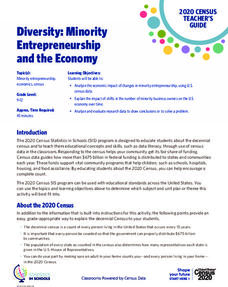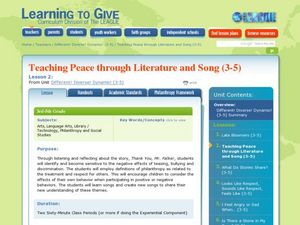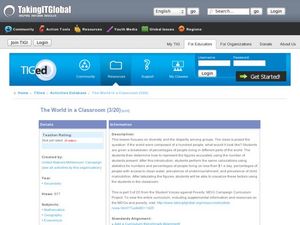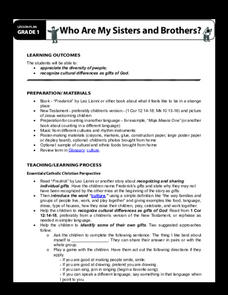Mikva Challenge
Deconstructing Campaign Messages and Perceptions
Target audience, covert message, explicit and implicit appeals. As part of an investigation of rhetorical devices used in campaign ads, class members examine and deconstruct the appeals in logos from...
LABScI
Genetic Equilibrium: Human Diversity
Investigate the Hardy-Weinberg Principle to explain genetic equilibrium. The 10th lesson plan of a series of 12 is a laboratory exploration of genetic equilibrium. Your classes use a mixture of beans to model allele and genotype...
CK-12 Foundation
Coefficient of Variation: Diverse Populations
What is the height of school clubs? Learners use sliders to calculate the coefficient of variation for three different school groups. Using the calculations, class members compare the variation in the heights of the groups.
EngageNY
Studying Conflicting Information: Varying Perspectives on the Pearl Harbor Attack, Part 1
Scholars read President Roosevelt's Day of Infamy speech and analyze the speech's words using close reading guides. Readers determine Roosevelt's point of view after reading the speech and filling in the guides.
EngageNY
Studying Conflicting Interpretations: Perspectives on Plessy v. Ferguson: Part 2
The Plessy v. Ferguson case was influential in establishing segregation in the United States. Scholars continue reading the court's decision in the case, seeking to understand the key reasons the court came to its decision. Pupils also...
US Department of Commerce
Diversity: Minority Entrepreneurship and the Economy
Using data from the Census Bureau, learners discover the growth in minority-owned businesses over time. After crunching numbers, analytical questions probe the reasons behind the shift.
US House of Representatives
A Growing Diversity, 1993–2017
Connect current events to the roles of AAPI members in Congress. Activities include tracing the impact of the Vietnam War on today's representatives. Learners have various options to explore, including role-play exercises and creating a...
K20 LEARN
The History of Spoken Word Poetry: Historical and Cultural Perspectives In Literature
Spoken word poetry, more than almost any other form, reveals the historical and cultural perspective of the poet. High schoolers listen to various spoken word poems, select one to research in-depth, and then apply what they have learned...
Curated OER
Measuring Biodiversity
Young scholars explore a few key concepts associated with measuring biodiversity. They are told that biodiversity can be measured in a number of ways. Genetic diversity is a measure of the genes represented in the sample. Ecosystem...
Curated OER
LEAGUE: Learning to Give
Students explore the effects of human actions. In this respect and discrimination lesson plan, students read Thank You, Mr. Falker and identify the consequences of bullying and teasing. Students then relate personal experiences of hurt...
Curated OER
Faces of the community (the): Art from the Heart
Students understand the selflessness of the artists Gauguin and Van Gogh. In this art lesson, students produce art work that reflects the diversity in the their school community. Students share their artwork to explain how they show...
Curated OER
School Redesign and Multiple Intelligences
Students examine their own intelligence to find areas of strength after studying the multiple intelligences. In this diverse learning styles lesson, students analyze how the school environment fosters or fails students of diverse...
Curated OER
Culture and Obesity
Students explore cultural perceptions regarding obesity. In this personal health lesson, students read case scenarios about 3 women and their health perceptions. Students discuss the women and the stereotypes associated with the women...
Curated OER
Heroes
Young scholars demonstrate racial awareness. For this diversity lesson, students read the book Heroes by Ken Mochizuki. Young scholars participate in a discussion about how the character was discriminated against. A follow-up reading of...
Curated OER
The World in a Classroom
Young scholars calculate percentages of different kinds of people in the world. In this diversity lesson plan, students will see the percentages of different people and different incomes based on if the world only had 100 people in it.
Curated OER
Where on Earth Are You From?
Students create family trees and discuss cultural differences. In this cultural diversity lesson, students discuss the places their families came from and develop questions for each other.Students show their families path of...
Curated OER
What Is an "Inquiry Lesson"?
Students complete inquiry projects. In this historical perspectives lesson, students conduct their own research on topical historical questions their instructors suggest. Students then locate historical evidence and analyze it to learn...
Curated OER
Defining Culture
Students explore cultural diversity. In this cultural awareness lesson plan, students examine the similarities and differences in various cultures and discuss the value of these differences.
Curated OER
Who are My Sisters and Brothers?
Students explore religion by completing a cultural diversity activity. In this human compassion lesson, students identify all of "God's Children" as their sisters and brothers. Students read the book Frederick in class and listen to...
Curated OER
Perspectives on Slavery
Students examine various perspectives on slavery. They read and evaluate historical writing and primary source documents, define vocabulary words, and complete worksheets.
Curated OER
Global Diversity Through Literature
Students investigate Southwest Indian Reservations. In this Native American lesson plan, students research Southwest Indian tribes on the Internet and by reading the book, Arrow to the Sun.
Curated OER
Diversity And Adaptations Of Organisms
Eighth graders study how and why animals are classified into eight groups in the animal kingdom. They work together to identify organisms. They use the key to determine the phylum for the included problems.
Curated OER
Diversity And Adaptations Of Organisms
Seventh graders demonstrate the processes of science by posing questions and investigating phenomena through language, methods and instruments of science. They study the body features or systems of several animals.
Curated OER
Perceptions of Canadians: A Sense of Belonging, Confidence and Trust
Students explore the concept of social capital. In this sociology lesson, students define social capital and discuss how it is developed in a culture.
Other popular searches
- Cultural Diversity
- Ethnic Diversity
- Animal Diversity
- Plant Diversity
- Diversity Scavenger Hunt
- Culture and Diversity
- Diversity Lesson Plans
- Diversity Crossword Puzzle
- Physical Diversity
- African Language Diversity
- Diversity Literature
- Diversity Music

























